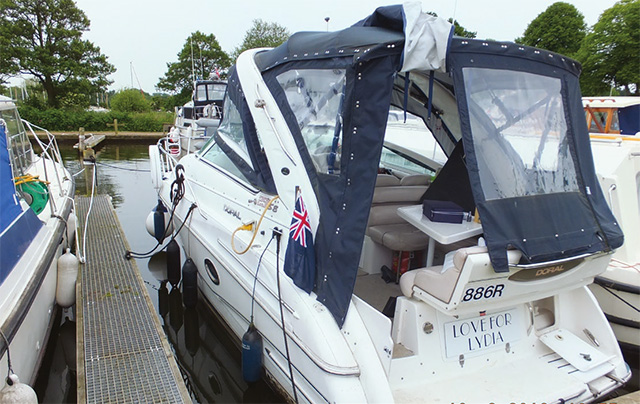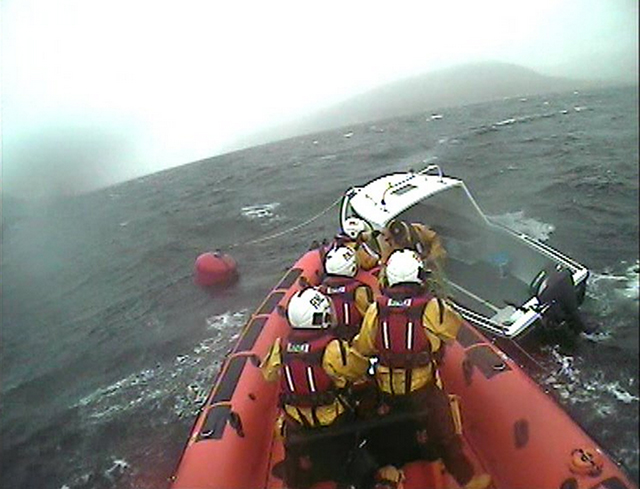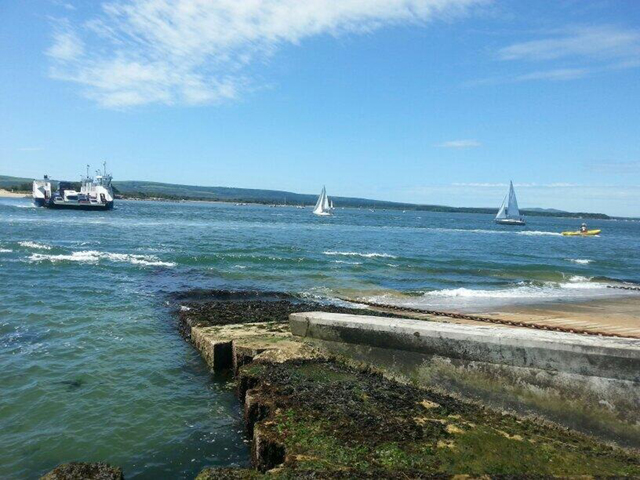As if loss of steering and starting to sink wasn’t bad enough, John Broadhead was forced to keep a cool head and think quickly when he became trapped in a locker while trying to stem the leak
One of the first events of the new sailing season for me is usually a shakedown cruise in company across Morecambe Bay to Piel Island with fellow Glasson Sailing Club members.
I overwinter my Copland 28 twin keel sloop Penny Diamond on her trailer at the club at Glasson Dock, but on this occasion forecast gales meant the shakedown cruise was cancelled, so the following week I decided to sail Penny Diamond single-handed down to her mooring on the River Conwy, some 65 nautical miles south.
The forecast was good, with north-east Force 4-5: leaving Glasson in late morning to use favourable tides down the River Lune and out of Morecambe Bay, I was in my element.
On a broad reach with full sail doing a good 6-7 knots, I thought I should be on the mooring at Conwy around HW midnight.
Off course and alarmed

By 2200 I had sailed well past Douglas gas rig with all its lights blazing astern. With Constable west cardinal flashing some three miles ahead, the alarm on the tiller pilot suddenly sounded, warning that we were off course.
I pressed the standby button and grabbed the tiller, only to find that I could not turn to port.
Dashing below to grab a torch, I saw that there was water above the cabin sole and running out of the engine cover. Looking over the stern, I could see the folding propeller wedged up around the transom hung rudder – the propshaft coupling had apparently come undone and the shaft had slid out until it hit the rudder.
When I opened the large single cockpit locker, it was half full of water. I climbed into the water throwing fenders, dinghy and soggy sails into the cockpit, but little did I know things were about to get worse.
Crawling on my stomach under the cockpit floor, I could feel the water gushing in through the open stern gland.
Suddenly, the boat decided to gybe: the locker hatch slammed shut and locked itself with the hasp and staple.
My torch fell into the water, and now it was pitch black.
I was trapped in the locker in a sinking boat. Penny Diamond was sailing round in circles, with water rushing from side to side every time she gybed, but I found that holding my hand over the stern gland hole stopped the inflow of water, at least giving me a little time to think what to do next.
I was wearing a fleece cap: screwing this into a point, I managed to stuff the cap in the hole to stem the leak.
I then lay on my back and stamped at the locker lid with both feet. Fortunately it burst open, bending the hasp and staple.
I was out of the locker in a flash: just to be out and in the open was a great relief, and after a few minutes I got my breath back.
Calling the coastguard
I sat in the cockpit working the manual bilge pump and, after what felt like ages, I eventually pumped the water out. Pulling hard on the tiller and lashing midposition, it was possible to steer a course for Great Orme.
With all this messing about I had lost a couple of hours: the tide was starting to ebb and the wind was dropping. Now with dry clothes on, and some feeling coming back to my fingers, I called Holyhead Coastguard on the VHF and told them of my dilemma: just to talk to someone was a real source of comfort.
When they asked if I needed assistance, I said that I didn’t at this stage. The bilge pump was now coping, with only a small amount of water leaking in, and my intentions were to try to sail for Conwy Bay and dry out on the beach near to Llandudno’s west shore.
The coastguard asked me to call them every half an hour with a progress report.
Luckily, the wind held east Force 2-3. Adjusting the sails helped to steer the boat and I managed to reach Deganwy Beach, where I ran aground around 0300, three hours past HW. I threw out the anchor and thanked the coastguard for keeping watch.
At first light and on a dry sandbank, it was easy to push the propshaft back in place and retighten the coupling, although the propshaft seemed slightly bent with me forcing the rudder to a neutral position.
As the tide returned there was no wind, but it was possible to motor slowly, and I eventually reached my mooring. Shortly afterwards the Conwy harbour master called me to offer assistance or arrange a tow. He told me that the coastguard had been in contact with him to say that I was aground near west shore.
LESSONS LEARNED
- Make sure that lockers can be opened from inside so you cannot become trapped. Penny Diamond is some 20 years old, and the locker fastener works only from outside.
- Carry various sizes of wooden bungs. This was only a one-inch hole, but trying to work underwater makes things a lot more difficult.
- Check the tightness of the propshaft coupling: to torque the coupling screws with ordinary Allen keys is not good enough.
- Carry several torches, preferably one suitable for underwater use. My LED torch failed as soon it touched the water.
- Luckily, I was wearing a non-automatic lifejacket: an automatic lifejacket would have inflated while I was lying in the
water in the locker, possibly trapping me under the cockpit floor.
ABOUT THE AUTHOR

John Broadhead
■ John Broadhead won the 2009 Isle Of Man Round the Island race in Penny Diamond, a Copland 28 twin keel sloop. He moved from Yorkshire to Conwy in 2004 to live beside the sea.
As published in the June 2011 issue of Practical Boat Owner magazine. For more archived articles browse the PBO Copy Service.
Send us your real-life experience – and win a painting of your boat!
Send us your real-life boating experience story and if it’s published in the magazine you’ll receive the original Dick Everitt-signed watercolour which is printed with the Learning from Experience article. Email pbo@timeinc.com
Gelcoat repair: How to make an invisible repair
Everything you need to know to make an invisible gelcoat repair, from preparation and filling to topcoat and polishing
Nav in a nutshell: Navigating at night
There’s no need to be in the dark if your preparation is thorough and easy to understand, says Dick Everitt…
Nav in a nutshell: Navigate with radar
Dick Everitt gives us a clear picture of the advantages to be gained from using radar to check our navigation
Nav in a nutshell: Looks good on paper
Up-to-date printed paper charts are a good bet for identifying your position – but they do have their limits, says…
Nav in a nutshell: Electronic charts
Dick Everitt assesses the differences between raster and vector charts when deciding on which chart plotter to buy
Nav in a nutshell: Coping with currents
Dick Everitt explains how sailors can apply knowledge of tidal streams to ensure that water flow is a help, not…
How to check keel bolts
Colin Brown describes a series of checks you can carry out to assess the structural integrity of the bolts which…
Nav in a nutshell: Know tidal vectors
'It’s easy for any sailor to remember how to draw tidal vectors with a handy little aide-mémoire!' Says Dick Everitt.…
Nav in a nutshell: Lee bowing defined
Dick Everitt explains how you can get a little lift from the tide
Safety warning after fatal carbon monoxide poisoning on motor cruiser
Lessons learned from a carbon monoxide boating tragedy on the Norfolk Broads, which killed a couple and their dog
Lessons learned from devastating yacht fire
‘Flames were licking out of the companionway’: yachtsman watched his beloved boat burn following two-year restoration
Lessons learned after yacht sinks during grounding recovery
“We deserved to get away with a few scratches and a bit of embarrassment, not to get the boat sunk”…
Nav in a nutshell: Making comfortable progress to windward
Why make heavy going in choppy conditions when a less demanding alternative heading will get you to your destination in…
Lifeboat crew assist skipper trapped in rough conditions
The Kyle of Lochalsh RNLI crew assisted a man who was trapped onboard a small boat in Glenelg bay due…
Lessons learned from MAIB reports
Lessons learned from a tragic speedboat ride, a "case of bad gas" and an incident involving a capsized yacht that…
Pensioner trapped under weight of yachting books
7,000 copies force ceiling's collapse
Lucky escape after inflatable dinghy collides with chain ferry
One man was dragged underneath the Dorset chain ferry when his dinghy's engine failed in its path





















